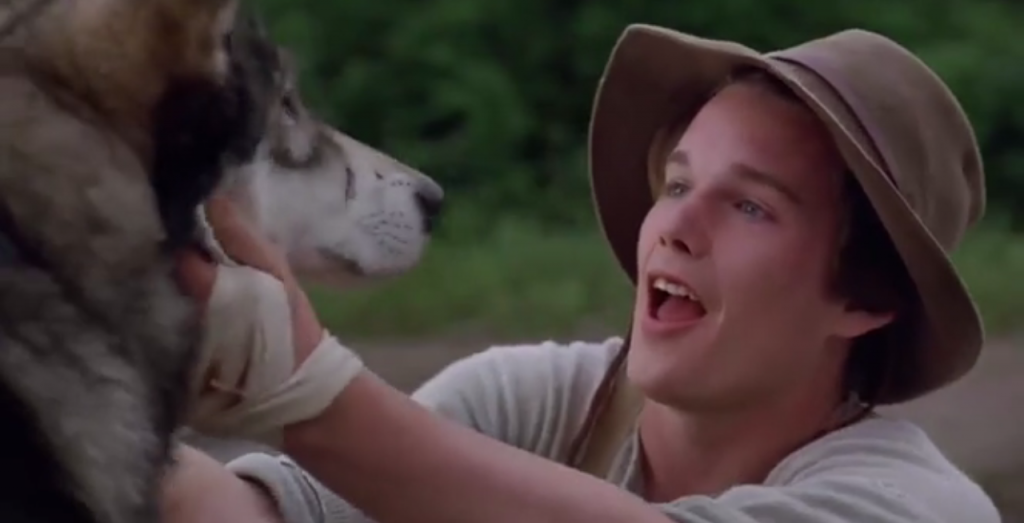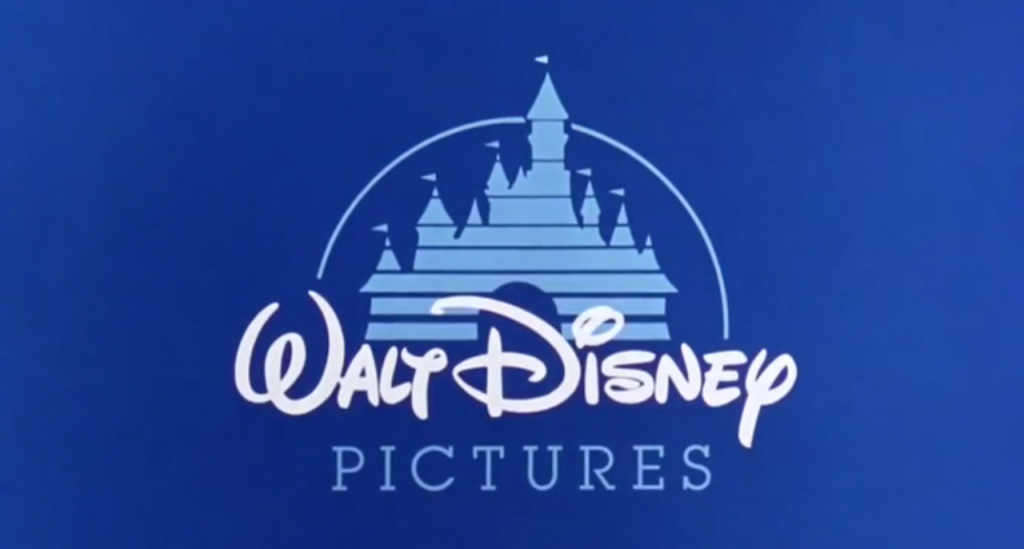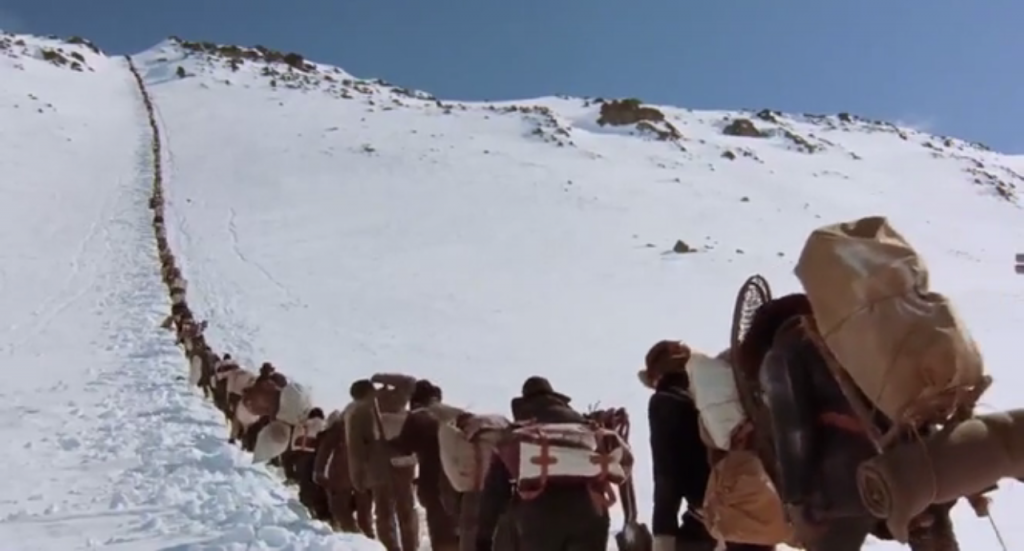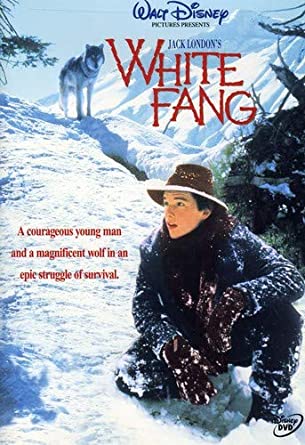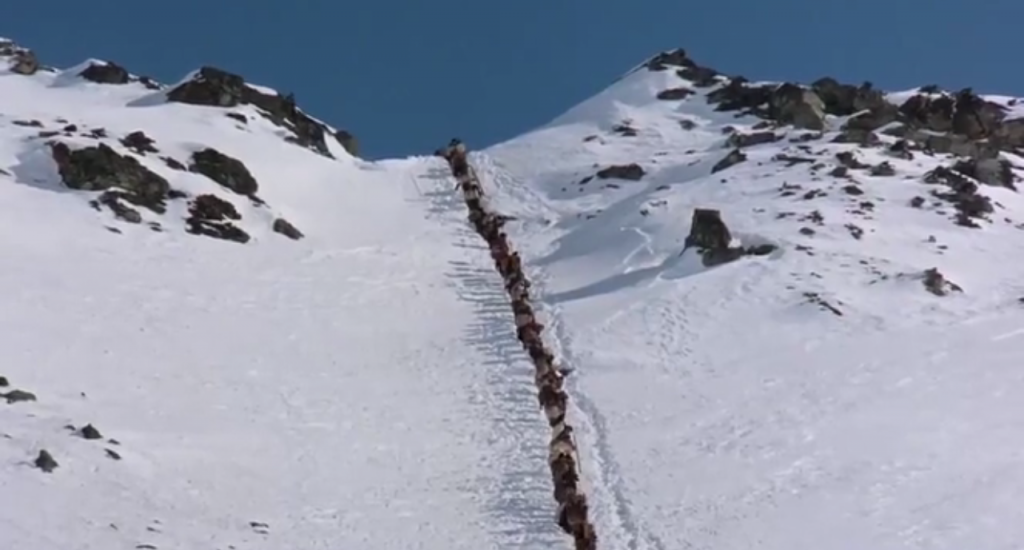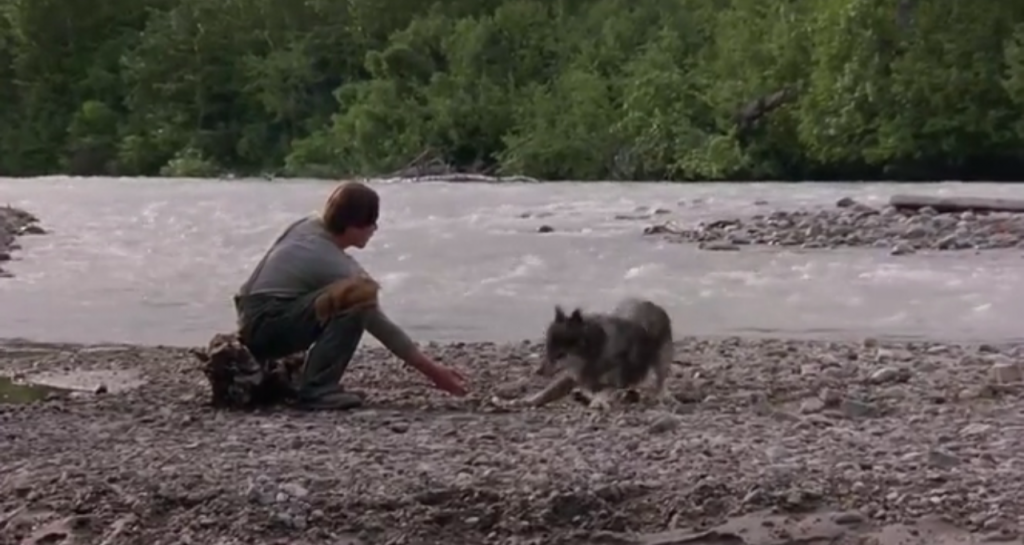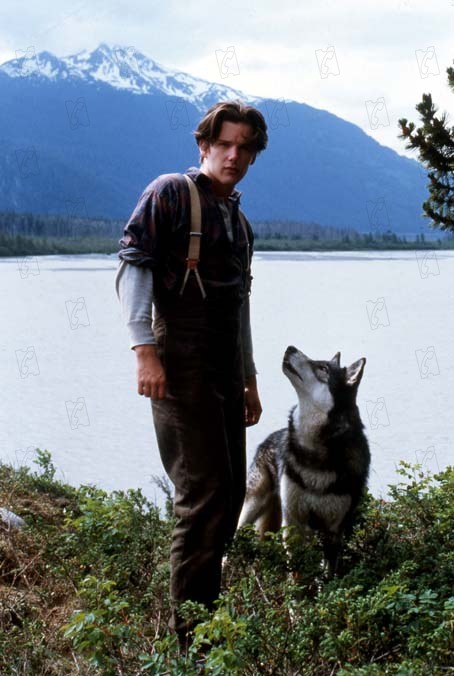Baring his teeth to a Grizzly Bear on its hind legs, White Fang- a hybridised wolf-dog, forsakes his life to defend a young boy, Jack Conroy. Jack’s endures a perilous journey across Alaskan terrain to discover his Father’s claim during the 1898 Klondike Gold Rush, and an orphaned wolf-dog puppy whose trust renders him a tool of human exploitation. Both paralleling narratives detail a journey of self-discovery that beautifully intertwines the emotional experiences of the human with the animal and culminates in the final climatic synergy of Man, Beast and Nature. Both orphaned and thrust upon a lonely world, only through their alliance can they reach autonomy, belonging and freedom, abandoning his return to San Francisco to live in unity away from human obstruction. Reduced to a snarling feral animal at the hands of human abuse, Jack coaxes White Fang into gaining his trust. Their relationship becomes a metaphor for the maturation of an adolescent, torn between what he knew and what he is to become, civilization and the wilderness.
As a Walt Disney Studios production, White Fang encompasses multiple genres to broaden its mass-market appeal and to withstand a house-hold Disney legacy. ‘The Disney name has become closely linked in the public mind with decent, family-orientated entertainment’ [1], meaning that Jack London’s 1906 product of literary naturalism is adapted to maintain a Family, Action and Adventure narrative that preserves ‘feel good’ family ethics. [2] For Action and Adventure films, ‘hostile natural environments are fundamental to the genre in all its manifestations’ [3] and the unforgiving Alaskan landscape serves as an enigmatic stage for the forging of their unbreakable bond. [4]
Furthermore, as their friendship matures, the natural world around them welcomes their union and relents. They return to a raw and simplistic way of life in order for both Man and Beast to break the restraints of modernity. They live the ‘masculinist fantasies’ [5] of the Western protagonists by mastering the wilderness and by opposing ‘Urbanization, industrialization, and commercialization… those very forces of conformity, mechanization, and materialism that threaten’. [6] Alex says ‘My dog’s don’t carry what they don’t need’ and burns Jack’s books, thus inaugurating his transition into manhood and the wilderness of the Yukon Territory. [7]
From Little Red Riding Hood to The Grey (2011) the superstition that folklore has constructed of the Wolf has created conflicting representations throughout literary history. Jesse argues that ‘legends depict the wolf as a nurturing maternal figure and a giver of life in some stories while a bloodthirsty beast of prey in others’. [8] Jesse goes on to explore the wolf as a symbol of intelligence, mastery and journey and the raw wilderness. The representation of pure breed wolves throughout White Fang depict them as ‘bloodthirsty’ yet intelligent- they encompass an astuteness that creates inextricable links to the human psyche.
To the people of the Yukon, the wolves serve as a threat against their survival. Hunted like prey, Alex, Skunker and Jack must tread precariously through the treacherous ‘wolf territory’, in a battle for dominance. Woolcott builds on Jesse’s observations of the Wolf through literary representations and discusses the wolf symbol in Native American custom, she argues that they ‘regard [the] Wolf as the way of find[ing] the deepest levels of self, of inner knowing and intuition’. [9] Kleiser visibly explores the innate ‘inner knowing and intuition’ of the animal and their heightened consciousness’s. Kleiser explores the fusion of wolf and human psyche as the wolves infiltrate Skunker’s dreams as a symbolic precursor for their contrived hunting of him and his beloved sled dog, Digger. White Fang’s mother utilises her recognition of being part-dog, part-wolf to outwit the humans and to lure Digger away from the camp. Klieser creates a dark depth using only the camp fire as light to create an ominous mise-en-scene.
The diegetic sound of the snarling wolves follows continuous, frantic camera angles of Skunker pursuing Digger into the depth of the woods and into the wolves unrelenting jaws. As a Family film, the violence of this scene is projected onto a close-up shot of Alex and Jack’s faces as they have no choice but to allow their friend to succumb to the psychological manipulation of the pack. The sound of gun shots and screams are interspersed with the snarling of the beasts tearing at his body. The camera angle then cuts to the domesticated dog’s which whimper that demonstrates the brutality of the wilderness versus the safety of domestication. White Fang explores the wolves as not only masters of their environment but of the human consciousness.
Furthermore, as a wild and orphaned puppy left to discover himself and the world around him, White Fang’s dual heritage renders him stranded between the two world’s of human governance and unrestrained wildness. After he leaves his mothers snowy corpse his journey of autonomy is portrayed using an aerial shot that emphasises his loneliness against the desolate, expansive environment. A deep focus shot follows White Fang to the pack of playing wolves and the non-diegetic sound of tribal drums is interspersed by the refined sound of a traditional flute. The flute, used consistently throughout White Fang, is reminiscent of Native American folk culture and the sound of the repetitive tambourine signifies this scene as White Fang’s ritualistic introduction into the Alaskan wilderness and the pack. However, White Fang remains on the periphery and as he chases them through the woods the ceremonial music fades out as he realises his displacement. This is mirrored in Jack’s introduction into the Alaskan wilderness and, in turn, manhood.A panning aerial shot highlights his separation from the other men as he struggles up the perilous Golden Staircase. A non-diegetic grandiose orchestra narrates his journey up the mountain and into the virile camp where the music fades as he is shunned by all who do not want the burden of an adolescent. Both Jack and White Fang’s narratives of self-discovery parallel one another as they are not accepted by either social sphere, thus highlighting the human-animal bond as more than functional relationship- a deep emotional and spiritual connection of two entities in search for belonging.
n the film. All the dogs throughout are defined by their function to man, either a fighting dog or sled-dog. During the dogfight the sounds of the jeering men fade into somber music as the close up, slow-motion camera angles capture the emotive brutality of the fight. The muscular physiques of both dog and wolf-dog are highlighted by slow-motion techniques. Subsequently reducing them to a commodity, a fleshy tool for men to exhibit as extensions of their masculinity and hierarchal mastery. Under the ownership of Beauty Smith, White Fang’s existence is typified by chains, bars and beating sticks. The stick, usually a natural tool of play for the domestic dog and man, becomes subverted to represent the violence of human governance. The human-dog relationships serve as a metaphor for the exploitative nature of man and reiterates Grey Beavers notion that ‘dog’s are for work’. This contrasts Jack and White Fang’s relationship which is built upon mutual respect. Crippled by the control of man, White Fang is reluctant to trust Jack at first and their trust is explored through visual poetry. An establishing shot shows Jack crouched parallel to a cowering White Fang against a tranquil Alaskan lake. An establishing shot moves into individual medium shots that alternate the focus on White Fang and Jack. Kleiser highlights the reciprocal nature of their relationship and in doing so stresses the sublimity of the animal-human bond, most importantly as one of communal respect. As a climatic completion of their unity, now both in the same shot, White Fang licks Jack’s wound as a primal representation of nurture and co-inhabitancy. The organic, diegetic sound of water trickling fuses their transcendent relationship with the vast beauty of the landscape and thus stresses the importance of the synergy of Man, Nature and Creature as integral triadic components of existence.
However, White Fang focuses on the importance of the separation of the wild and the domestic. Kleiser depicts a natural world that is encroached on by human ego, the tamed animals become instruments for human exploitation and the wild animals endanger and eliminate human life. Only because White Fang is a hybridized product of these two worlds is he allowed to transcend these natural laws of existence. Mining the natural landscape for gold destroys the untainted surroundings and the wild animals within the film respond to this with a primal, protective violence. White Fang and Jack’s relationship is centered around mutual respect and dependence, symbolically representing the possibilities of human-animal-environmental benevolence and unison. Nevertheless, if the film is a symbolic representation of the importance of the natural world working together, this is undercut by the films barbaric, unrealistic representation of wolves that are vilified. Kleiser portrays the contradictory message that these beasts can only be kept at bay with reciprocal violence.
[1] Joel Best and Kathleen Lowney, ‘The Disadvantage of a Good Reputation: Disney as a Target for Social Problems’, The Sociological Quarterly, 50.3, (2009), 431-449 (p. 433).
[2] Noel Brown, ‘The ‘Family’ Film and the Tensions Between Popular and Academic Interpretations of Genre’, Trespassing Journal: an online journal of trespassing art, science, and philosophy 2, (2013), P.7
[3] Yvonne Tasker, The Hollywood Action and Adventure Film (London: John Wiley and Sons, 2015), p. 2. ulie, Anne J putation: Disney ae.corpse uman psyche as ther and grounded his relevance within the Hollywood tradition to give.
[4] Ibid, p.2
[5] Julie Ann Kohler, No Goin’ Back: Modernity and the Film Western (United States of America: Bringham Young University, 2014), p. 5.
[6] Paul Seydor, Pekinpah: The Western Films- A Reconsideration (Chicago: University of Illinois Press, 1999), p. 360.
[7] White Fang, dir. by Randal Kleiser (Buena Vista Pictures, 1991).
[8] Lisa Jesse, Wolves in Western Literature (Knoxville: University of Tennessee, 2000), p. 5.
[9] Ina Woolcott, Wolf Power Animal Symbol of Wildness, Social and Family Values (2016) http://www.shamanicjourney.com/wolf-power-animal-symbol-of-wildness-social-and-family-values [accessed 18 January 2016].
Bibliography
Best, Joel and Lowney, Kathleen, ‘The Disadvantage of a Good Reputation: Disney as a Target for Social Problems’, The Sociological Quarterly, 50.3, (2009), 431-449 (p. 433).
Brown, Noel ‘The ‘Family’ Film and the Tensions Between Popular and Academic Interpretations of Genre (London: John Wiley and Sons, Yvonne Tasker), p. 2.
Jesse, Lisa, Wolves in Western Literature (Knoxville: University of Tennessee, 2000), p. 5.
Kohler, A Julie, No Goin’ Back: Modernity and the Film Western (United States of America: Bringham Young University, 2014), p. 5.
Seydor, Paul, Pekinpah: The Western Films- A Reconsideration (Chicago: University of Illinois Press, 1999), p. 360.
Tasker, Yvonne, The Hollywood Action and Adventure Film (London: John Wiley and Sons, 2015), p. 2.
White Fang, dir. by Randal Kleiser (Buena Vista Pictures, 1991).
Review
http://www.rogerebert.com/reviews/white-fang-1991
http://www.nytimes.com/movie/review?res=9D0CE7DB1430F93BA25752C0A967958260
http://articles.latimes.com/1991-01-18/entertainment/ca-313_1_white-fang
